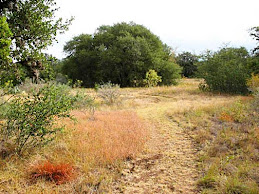We have been harvesting lettuce, mesclun, arugula, turnip greens, and kale for several weeks now. Friday we ate the first asparagus of the season. (It's in the back row, where the tall wooden trellis keeps its summery fronds from falling into the next bed.) Three kinds of onion sets are on the left, and we are finishing the raised bed to the right this weekend.
Except for the top edge, which we use as a seat when we weed, everything has been accomplished with free scrap wood. We hope to get the left side of the garden just out of the picture raised this spring. Both are already drip irrigated. The two tall structures are trellis towers which still need to be strung for beans. After last year's entanglement of morning glories we'll let the legumes have them this year.
Here I am totally covered by spent flower vines taken off the trellis this fall in an attempt to sneek up and startle my spouse. It would make a clever costume for a botanist at a masquerade party don't you think?

Phoebe and her son Finley, our rescue Barbados Blackbelly sheep, are admiring the winter greens. We line our paths with the pine shavings taken from our chicken coop and compost the rest. It's a nice system.
















